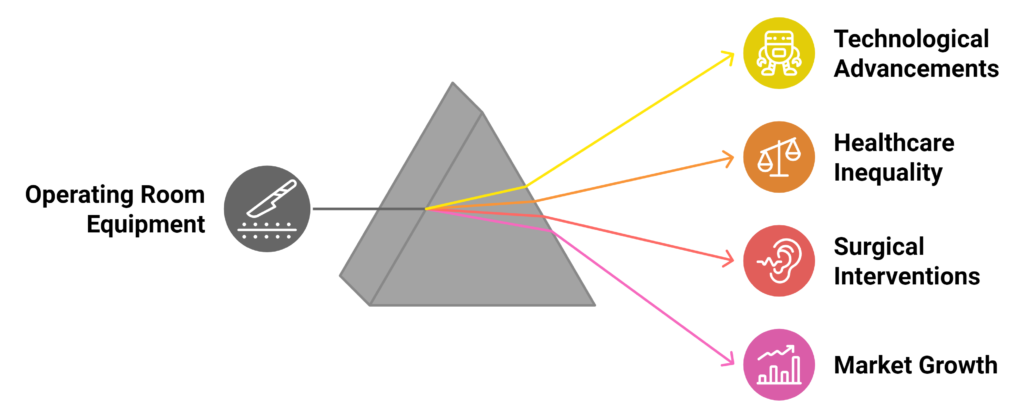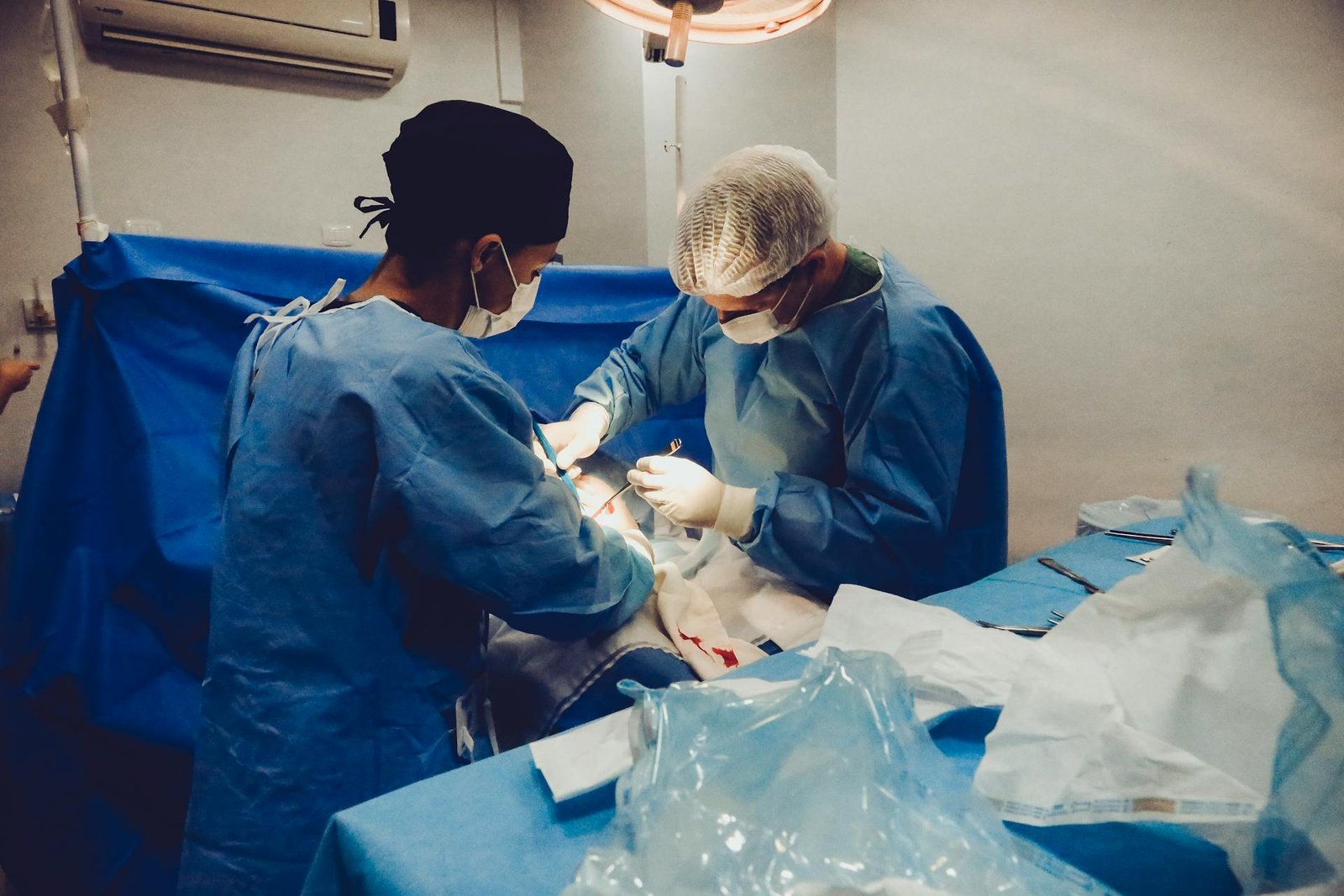Introduction
The global operating room equipment market is projected to reach $27.4 billion by 2030, driven by a compound annual growth rate (CAGR) of 5.3% from 2021 to 2030. This robust growth is attributed to key factors such as the rising incidence of surgeries, technological advancements, and increased healthcare spending. However, as the market surges, we must ask: Are we overlooking the significant risks and challenges that come with this growth? This article critically explores the business opportunities, controversies, and ethical dilemmas facing the global operating room equipment market, exposing the widening gaps in healthcare access, the unsustainable rise in healthcare expenditures, and the ethical concerns surrounding technological advancements.
Driving Forces Behind Market Growth
Rising Incidence of Surgeries: A Blessing or a Burden?
One of the primary drivers behind the rapid expansion of the operating room equipment market is the increasing number of surgeries performed worldwide. As chronic diseases like cancer, cardiovascular diseases, and diabetes become more prevalent, the demand for surgical interventions continues to rise.
Emotional Appeal: Lives Depend on These Innovations
Surgical procedures often mean the difference between life and death for millions of patients, and operating room equipment plays a critical role in ensuring successful outcomes. From advanced surgical imaging systems to anesthesia devices, cutting-edge technology is now a necessity in modern medicine. However, the emotional toll on families and the healthcare system cannot be ignored. Patients and families place their trust in these technologies, expecting them to save lives. But are these systems truly accessible to everyone?
Controversy: A Healthcare System on the Brink?
While the rising number of surgeries indicates an increased demand for operating room equipment, it also raises questions about the healthcare system’s capacity to handle this surge. Many healthcare facilities, particularly in underdeveloped regions, lack the infrastructure to adopt advanced surgical technologies. Could this lead to a healthcare crisis, where only the wealthy have access to life-saving surgeries, while others are left behind?
Technological Advancements: Innovation or Disparity?
Examples of Innovations: Pushing the Boundaries of Possibility
Technological advancements in operating room equipment, including robotic surgery systems, artificial intelligence (AI)-driven tools, and minimally invasive surgical devices, are reshaping how surgeries are performed. These innovations are designed to increase precision, reduce recovery times, and enhance patient care. Companies like Medtronic and Stryker Corporation are leading the charge in developing cutting-edge equipment that promises to revolutionize the healthcare industry.
Critical Perspective: Are We Widening the Healthcare Divide?
While these advancements are impressive, they are also expensive. Hospitals in developed nations are the primary beneficiaries of these innovations, while facilities in lower-income countries are often left behind. The global healthcare divide is widening, as technologically advanced hospitals in North America and Europe thrive, while those in regions like Africa and parts of Asia struggle to keep up. Is it ethical for companies to prioritize profit over the equitable distribution of these life-saving technologies?
Increasing Healthcare Expenditures: Opportunity or Catastrophe?
Business Focus: A Lucrative Market for Manufacturers
With more investments pouring into healthcare infrastructure, hospitals and surgical centers are racing to modernize their facilities. This creates significant opportunities for operating room equipment manufacturers to expand their market share. The establishment of new hospitals, particularly in emerging markets, will drive demand for surgical lights, operating tables, and anesthesia devices.
Critique: Unsustainable Healthcare Costs?
However, there’s a darker side to this growth. Healthcare expenditures are rising at an unsustainable rate, and hospitals are passing these costs onto patients. In many regions, access to surgical care is becoming a privilege rather than a right. The increasing costs of high-tech operating room equipment are contributing to the growing financial burden on patients and healthcare providers alike. How long can this trend continue before the system collapses under its own weight?

Market Segmentation and Business Opportunities
By Product Type: Unlocking New Frontiers
Operating Tables: The Backbone of Modern Surgery
Operating tables are a crucial component of any surgical procedure. Technological improvements in adjustable, ergonomic, and image-compatible tables are making surgeries more efficient and less physically taxing on surgeons. These innovations are especially beneficial for complex procedures like neurosurgery and cardiovascular surgeries.
Surgical Lights: Illuminating the Future of Surgery
Surgical lights are now equipped with advanced features like shadow management and adjustable color temperature, ensuring surgeons have a clear, unobstructed view during procedures. Manufacturers are continuously innovating to create energy-efficient and eco-friendly lighting systems that enhance surgical precision.
Surgical Imaging Systems: A Booming Segment
One of the fastest-growing segments in the operating room equipment market is surgical imaging systems. These systems, including fluoroscopy and 3D imaging, are enabling surgeons to perform minimally invasive surgeries with greater accuracy. This segment is expected to see the highest growth, driven by demand for advanced imaging solutions that minimize patient risk.
Anesthesia Devices: A Life-Saving Necessity
The role of anesthesia devices in modern surgery cannot be overstated. Innovations in automated anesthesia systems are making surgeries safer by ensuring precise delivery of anesthesia, reducing the risk of human error.
By End-User: Hospitals vs. Ambulatory Surgical Centers
Hospitals: The Primary Buyers
Hospitals remain the largest end-users of operating room equipment. They are continually upgrading their facilities with state-of-the-art equipment to meet the growing demand for complex surgeries. However, hospitals are also facing financial pressures, as they struggle to balance the need for innovation with budget constraints.
Ambulatory Surgical Centers (ASCs): A Growing Trend
Ambulatory Surgical Centers (ASCs) are emerging as a significant player in the operating room equipment market. Offering outpatient surgeries, ASCs are a cost-effective alternative to hospitals. They focus on low-risk procedures that don’t require long hospital stays, making them an attractive option for patients. However, the rapid expansion of ASCs raises concerns about the potential for cost-cutting measures that could compromise patient care.
Critique: Are ASCs Compromising Quality for Affordability?
While ASCs provide a lower-cost option for patients, critics argue that this focus on cost reduction could result in a decline in quality of care. Surgeons working in these centers may face pressure to perform procedures more quickly, potentially leading to mistakes. Additionally, some ASCs may not have the same level of access to advanced equipment found in hospitals, raising concerns about patient safety.

Regional Market Insights and Criticisms
North America’s Dominance: A Market of Privilege?
Business Advantage: Advanced Healthcare Infrastructure
North America, particularly the United States, is expected to dominate the operating room equipment market. The region boasts an advanced healthcare infrastructure, and the high volume of surgeries performed here creates a strong demand for cutting-edge equipment. Manufacturers are flocking to this region, as the U.S. healthcare system is well-funded and eager to adopt the latest technologies.
Controversial Viewpoint: Are We Catering Only to the Wealthy?
While North America’s dominance in the market is good news for manufacturers, it raises ethical questions about global healthcare inequality. Is the focus on wealthy markets like North America and Europe ignoring the needs of underdeveloped regions? By catering to the wealthiest healthcare systems, are manufacturers widening the global gap in access to life-saving operating room equipment?
Asia-Pacific: The Fastest-Growing Region—But at What Cost?
Opportunities for Investment: A Lucrative Emerging Market
The Asia-Pacific region is expected to see the fastest growth in the operating room equipment market, driven by increasing healthcare investments in countries like China and India. With a large patient population and rising healthcare needs, this region presents significant opportunities for manufacturers and investors.
Criticism: Profit-Driven Growth at the Expense of Patients?
However, the rapid expansion in Asia-Pacific comes with risks. Critics argue that the focus on growth and profits may lead to over-commercialization, where patient care and safety take a back seat. Additionally, many hospitals in this region lack the regulatory oversight and infrastructure necessary to properly implement these advanced technologies. Is the rush for profit compromising patient care in emerging markets?
Competitive Landscape: Leaders, Laggards, and Ethical Concerns
Key Players: Medtronic, Stryker Corporation, and Others
Medtronic: Leading the Charge in Technological Innovation
Medtronic is one of the largest players in the operating room equipment market, known for its innovations in robotic surgery systems and minimally invasive devices. The company has made significant investments in AI-driven surgical solutions, positioning itself as a leader in the industry.
Stryker Corporation: Pushing Boundaries in Surgical Imaging
Stryker Corporation is another key player, particularly in the surgical imaging space. The company’s products are used in hospitals worldwide, offering advanced solutions that enable surgeons to perform more precise procedures.
Ethical Concerns: Pricing Out the Poor?
While these companies are at the forefront of technological advancements, they are also under scrutiny for their pricing strategies. The cost of their cutting-edge equipment is often out of reach for hospitals in developing nations. Are these companies doing enough to make their technologies accessible to lower-income regions, or are they prioritizing profits over equitable healthcare?
Critique: Is Technology Alone Enough to Sustain Growth?
Overreliance on Technology: Are We Neglecting Infrastructure?
While technological advancements are a key driver of growth, they are not a panacea for the challenges facing the global healthcare system. Many regions still lack basic infrastructure, making it impossible for hospitals to adopt the latest technologies. In some cases, hospitals invest in high-tech equipment, only to find they cannot maintain or operate it due to a lack of training and resources.
Healthcare Inequality: The Growing Divide
The divide between regions with access to advanced operating room equipment and those without is growing. In wealthy countries, patients benefit from the latest innovations, while in poorer regions, basic surgical tools are still in use. Is it ethical for the market to continue focusing on high-margin products for the wealthiest hospitals, while millions of patients in lower-income countries are left without access to life-saving surgeries?
Customer Mindset and Trends in the Global Operating Room Equipment Market
Understanding the customer mindset and emerging trends is crucial for businesses looking to capitalize on the rapidly growing operating room equipment market, projected to reach $27.4 billion by 2030. As healthcare systems evolve and patient expectations shift, the preferences of healthcare providers (the primary customers in this market) are changing significantly. Key trends include the growing demand for innovative technology, an emphasis on cost-efficiency, and a rising focus on patient safety and outcomes. However, these trends are also shaped by various challenges such as budget constraints, regulatory requirements, and the global divide in access to healthcare technology.
1. Demand for Cutting-Edge Technology
Customer Mindset: Investing in Future-Proof Solutions
Hospitals, surgical centers, and other healthcare facilities are increasingly prioritizing investments in cutting-edge technologies that promise to improve surgical precision, patient safety, and operational efficiency. Robotic surgery systems, AI-driven imaging tools, and automated anesthesia devices are at the forefront of customer demand, with healthcare providers seeking equipment that can enhance surgical outcomes and minimize human error.
- Trend: Hospitals want technology that is future-proof. They seek innovations that not only meet current demands but also integrate easily with other systems as they evolve.
- Drivers: The need for precision, minimally invasive surgery, and reduced recovery times is influencing purchasing decisions, as customers look for equipment that can deliver superior clinical outcomes.
While advanced technologies are in high demand, the high price points are often out of reach for hospitals in underdeveloped regions. This growing disparity is creating a two-tier healthcare system, where wealthier institutions are equipped with the latest innovations, leaving those with fewer resources behind.
2. Cost-Efficiency and Return on Investment (ROI)
Customer Mindset: Balancing Quality and Cost
In many healthcare systems, particularly in developing economies, cost-efficiency is a key consideration. Healthcare providers are increasingly scrutinizing the return on investment (ROI) of expensive equipment. They are looking for solutions that deliver value for money, without compromising on quality or patient outcomes. The financial pressure on hospitals, especially in regions with limited budgets, means they must weigh the benefits of state-of-the-art equipment against its costs.
- Trend: A rising preference for cost-effective solutions that provide high-quality performance at a lower total cost of ownership. This is particularly evident in regions where healthcare infrastructure is still developing.
- Drivers: Budget constraints and the growing pressure to deliver more surgeries in a shorter time frame are driving demand for affordable but high-performing operating room equipment.
There is a risk that the push for cost-efficiency could lead to corners being cut, particularly in ambulatory surgical centers (ASCs) where cost-saving measures may compromise patient safety and quality of care. The challenge for manufacturers is to create affordable solutions without reducing the performance or reliability of the equipment.
3. Focus on Patient Safety and Outcomes
Customer Mindset: Prioritizing Patient-Centered Care
With increasing emphasis on patient outcomes, healthcare providers are focused on operating room equipment that enhances the safety and success of surgical procedures. Equipment that can help reduce infections, complications, and human error is in high demand. Hospitals want tools that help improve surgical precision and ensure minimal patient downtime, ultimately leading to better patient satisfaction.
- Trend: Surgeons and hospitals are prioritizing tools that enhance patient safety, reduce complications, and shorten recovery times. Minimally invasive technologies and systems with AI capabilities are gaining traction as they reduce the risk of human error.
- Drivers: Increasingly informed patients, coupled with the need to adhere to strict healthcare regulations, are driving the shift toward patient-centered care and the demand for equipment that can help deliver consistent and safer outcomes.
Despite the focus on safety and outcomes, there is concern that the high cost of advanced operating room equipment might price some patients out of receiving the best possible care. The ongoing debate about the commercialization of healthcare raises ethical concerns about whether patients in less affluent regions are being deprived of life-saving surgeries due to the profit-driven focus of equipment manufacturers.
4. Sustainability and Green Healthcare Initiatives
Customer Mindset: Environmentally Conscious Healthcare
As environmental awareness grows, there is an increasing demand for sustainable healthcare solutions. Hospitals and surgical centers are under pressure to reduce their carbon footprint and minimize waste. This shift is influencing purchasing decisions, with healthcare providers seeking energy-efficient equipment, reusable tools, and systems that reduce environmental impact.
- Trend: Hospitals are beginning to favor equipment that aligns with green healthcare initiatives. This includes energy-efficient lighting systems, low-power imaging devices, and recyclable or reusable materials in surgical equipment.
- Drivers: Growing concern about the environmental impact of healthcare practices, as well as regulations that encourage hospitals to adopt sustainable and eco-friendly technologies.
While sustainability is a growing concern, the cost of eco-friendly equipment can be higher, leading to a slower adoption rate, particularly in less affluent regions. There’s also skepticism about whether sustainable technologies can truly perform at the same level as their traditional counterparts without sacrificing quality or patient care.
5. Customization and Flexibility
Customer Mindset: Tailored Solutions for Diverse Needs
Healthcare providers are increasingly looking for customizable and flexible equipment that can cater to the diverse needs of their surgical teams and patient populations. Modular designs that allow hospitals to adapt their operating rooms based on specific surgical requirements are in high demand. The ability to scale and adjust equipment configurations to meet the demands of specialized surgeries offers significant value to hospitals.
- Trend: The demand for customizable operating room equipment that offers flexibility for different types of surgeries is rising. Hospitals are looking for solutions that can be easily adapted for general surgery, cardiac surgery, orthopedic surgery, and more.
- Drivers: Increasing specialization in healthcare and the need for cost-effective solutions that serve multiple functions in a hospital’s operating room.
While customizable solutions offer flexibility, there is concern that highly specialized equipment might increase complexity and lead to more downtime due to maintenance issues or training requirements. Additionally, it might push up costs unnecessarily for hospitals that perform more general surgeries, making them pay for features they don’t need.
6. The Rise of Digital and Connected Operating Rooms
Customer Mindset: The Smart OR of the Future
With the rise of IoT (Internet of Things) and AI-driven technologies, hospitals are moving toward digitally connected operating rooms. These smart operating rooms integrate equipment, patient data, and surgical procedures into a seamless, real-time system. Surgeons can use digital dashboards to monitor patient vital signs, equipment functionality, and surgical imaging systems in one integrated platform, optimizing surgical precision and improving outcomes.
- Trend: Hospitals are adopting smart OR technologies, where equipment is interconnected, and data is shared in real-time to enhance the surgeon’s ability to make critical decisions during surgery.
- Drivers: The push toward digital transformation in healthcare, as well as the growing use of AI, robotics, and data analytics, is driving demand for integrated OR systems.
While digital transformation promises improved patient care, it also introduces risks. Data security is a major concern, as hospitals must protect sensitive patient information in the face of increasing cyber threats. Additionally, there are ethical concerns about relying too heavily on AI in the operating room—what happens if the AI makes a mistake, and who is liable?
Conclusion
The global operating room equipment market is on track to reach $27.4 billion by 2030, driven by technological advancements, rising healthcare expenditures, and the increasing incidence of surgeries. However, as the market grows, we must not overlook the risks and challenges that accompany this rapid expansion. The global healthcare divide, unsustainable healthcare costs, and ethical concerns about access to technology are critical issues that must be addressed.
The future of operating room technology is exciting, but it will be incomplete if only the wealthiest regions can benefit. Companies, healthcare providers, and governments must work together to ensure that these life-saving technologies are accessible to everyone, regardless of their geographic location or income level.
Final Thought: A Call for Equitable Healthcare Access
The innovations in operating room equipment hold the potential to save countless lives, but only if they are accessible to all. We must prioritize equitable distribution, ensuring that healthcare technology benefits the many, not just the few. The future of healthcare depends on our ability to bridge the gap between technological innovation and global healthcare inequality.
Citations:
[1] https://www.grandviewresearch.com/industry-analysis/operating-room-equipment-market
[2] https://www.industryarc.com/Report/7381/Operating-Room-Equipment-Market-Research-Report.html
[3] https://www.transparencymarketresearch.com/operating-room-equipment-market.html
[4] https://www.psmarketresearch.com/market-analysis/operating-room-equipment-market
[5] https://www.grandviewresearch.com/horizon/outlook/operating-room-equipment-market/india
Latest Posts:
- $6.6 Billion by 2033: Is the Aircraft Lighting Industry Flying Blind?
- $27.4 Billion by 2030: Are We Overlooking the Risks in the Operating Room Equipment Market?
- From $7.2 Billion to $10.8 Billion: What’s Driving the Growth of Undercarriage Components Market?
- U.S. Dental Market to Hit $260 Billion by 2033: What’s Driving the Growth?
- Bouncing Back Stronger: Strategies to Inspire Your Team After a Project Setback

